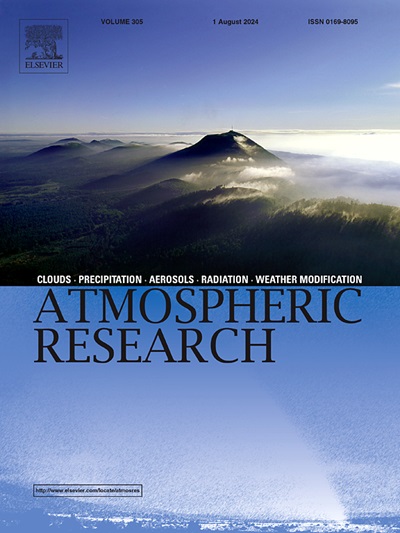On the spatio-temporal coherence of extreme precipitation indices in subtropical Argentina
IF 4.5
2区 地球科学
Q1 METEOROLOGY & ATMOSPHERIC SCIENCES
引用次数: 0
Abstract
This study evaluates the spatio-temporal coherence of regional extreme precipitation indices in subtropical Argentina (STAr) derived from rain gauge station data from 1991 to 2021. For the regionalization two machine learning clustering algorithms are used—Ward's method and K-means—and a novel stepwise regionalization approach, HAZ. While machine learning algorithms require the apriori definition of the optimal number of clusters, which varies considerably with the used metric and selection criteria, the HAZ method relies on a Pearson's correlation coefficient threshold and avoids this limitation. In most cases machine learning algorithms struggled to produce coherent regions, with fewer clusters prioritizing spatial coherence at the expense of temporal consistency, and vice versa. Conversely, the HAZ method systematically outperformed machine learning approaches, providing regions with adequate spatio-temporal coherence. Notably, HAZ permits some stations to remain unclustered, allowing to reflect the local variability in extreme precipitation. The overall good performance of the HAZ method demonstrates its potential for broader applications in hydro-climatic studies. Moreover, two intensity indices were unsuitable for regionalization due to poor coherence, while the other three were prone to regionalization throughout the year. The Accumulated index, particularly using the 95th percentile as a threshold, emerged as the most representative, effectively synthesizing extreme precipitation characteristics in STAr. Finally, the necessity of validating the spatio-temporal internal coherence of clustering algorithms outputs is emphasized to avoid mischaracterization and ensure robust regionalization results.
阿根廷亚热带地区极端降水指数时空相干性研究
利用1991 - 2021年阿根廷副热带地区雨量站资料,对区域极端降水指数的时空相干性进行了评价。对于区域化,使用了两种机器学习聚类算法- ward方法和k -means -以及一种新的逐步区域化方法HAZ。虽然机器学习算法需要先验定义最优聚类数量,这与使用的度量和选择标准有很大不同,但HAZ方法依赖于Pearson的相关系数阈值并避免了这种限制。在大多数情况下,机器学习算法难以产生连贯的区域,较少的集群以牺牲时间一致性为代价优先考虑空间一致性,反之亦然。相反,HAZ方法系统地优于机器学习方法,为区域提供足够的时空一致性。值得注意的是,HAZ允许一些站点保持非聚集状态,从而可以反映极端降水的局部变率。热影响区方法的整体良好性能表明其在水文气候研究中具有更广泛的应用潜力。其中2个强度指标的一致性较差,不适合区域化,其余3个指标全年都有区域化倾向。以第95百分位为阈值的累积指数最具代表性,有效地综合了STAr极端降水特征。最后,强调了验证聚类算法输出的时空内部一致性的必要性,以避免错误表征并确保分区结果的鲁棒性。
本文章由计算机程序翻译,如有差异,请以英文原文为准。
求助全文
约1分钟内获得全文
求助全文
来源期刊

Atmospheric Research
地学-气象与大气科学
CiteScore
9.40
自引率
10.90%
发文量
460
审稿时长
47 days
期刊介绍:
The journal publishes scientific papers (research papers, review articles, letters and notes) dealing with the part of the atmosphere where meteorological events occur. Attention is given to all processes extending from the earth surface to the tropopause, but special emphasis continues to be devoted to the physics of clouds, mesoscale meteorology and air pollution, i.e. atmospheric aerosols; microphysical processes; cloud dynamics and thermodynamics; numerical simulation, climatology, climate change and weather modification.
 求助内容:
求助内容: 应助结果提醒方式:
应助结果提醒方式:


